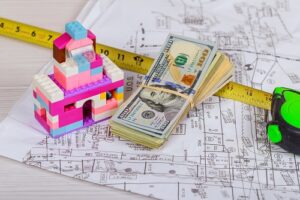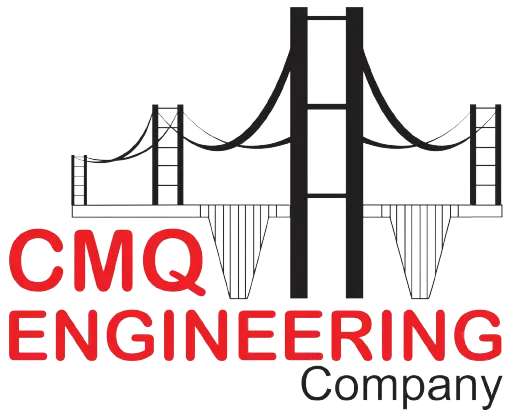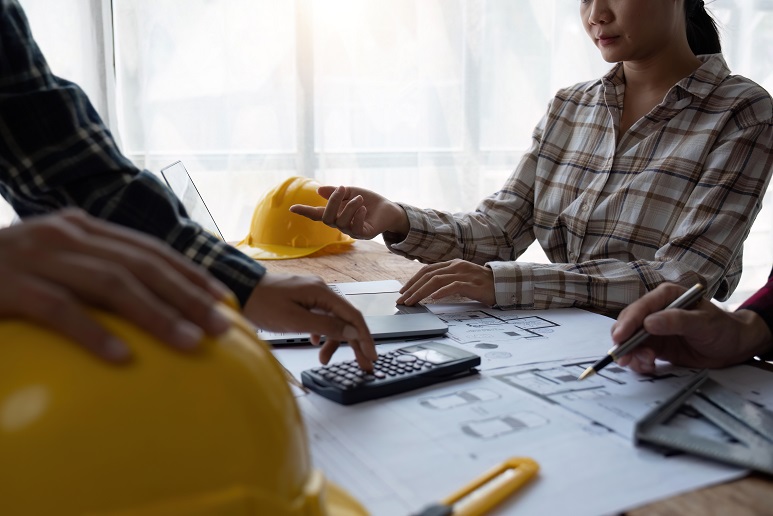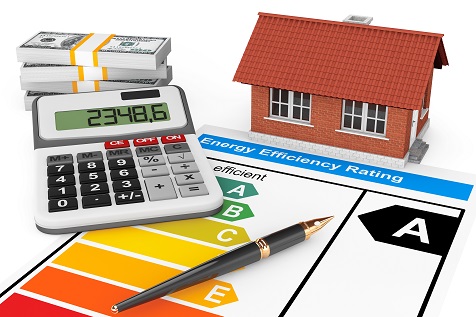Are you ready to turn your dream home into a reality but need help figuring out where to start when it comes to estimating construction costs?
Look no further! In this blog post, we will break down the critical factors in estimating new home construction costs so you can confidently plan and budget for your project.
Whether building from scratch or embarking on a significant renovation, we’ve got you covered with expert tips and insider insights.
Understanding The Basics
Before starting any new home construction project, it is crucial to have a solid understanding of the basics of estimating costs. This will help you create an accurate budget and prevent any unexpected expenses throughout the construction process.
Create a Detailed Plan
The first step in estimating new home construction costs is to create a detailed plan or blueprint for your dream home. This should include all the necessary details, such as size, number of rooms, type, and quality of materials, as well as any additional features or upgrades you want to include.
Know Your Local Building Codes
It is crucial to familiarize yourself with local building codes before estimating costs. These codes dictate what can and cannot be done regarding design, materials, and construction methods. Please comply with these codes to avoid costly changes later on.
Consider Location
The location of your new home can significantly impact construction costs. Factors such as soil conditions, accessibility, and proximity to utilities can affect the cost estimation.
Material Costs
Researching the current prices of building materials in your area is critical to creating an accurate estimate. Remember that material costs can vary significantly depending on quality and availability.
Labor Costs
Labor is another significant expense when it comes to new home construction costs. Research average labor rates for skilled workers in your area, including architects, contractors, plumbers, and electricians, is vital.
Total Square Footage Cost
A common way to calculate total construction cost estimates is using the price per square foot method, which considers size, complexity, location, and build type (i.e., single-family vs multi-family).
Additional Expenses
Apart from material and labor costs, other expenses must be factored into your estimate, such as permit fees, taxes, insurance, utility connections, landscaping, interior finishes such as paint, flooring, and fixtures, and any unexpected costs that may arise during construction.
Contingency Plan
It is advised to always add a contingency of 10-20% to your estimated cost in case of unforeseen expenses or changes in the plan.
Estimating new home construction costs can seem overwhelming, but with proper planning and understanding of the essential factors, you can create a realistic budget for your dream home. Remember to do thorough research, consider all variables, and have a contingency plan to avoid surprises down the road.
Size and Complexity

When estimating new home construction costs, one of the most significant factors to consider is the size and complexity of the project.
The size and complexity of a home can significantly impact the overall cost, as more materials, labor, and time may be required for larger or more intricate designs.
The first thing to consider when looking at the size of a new home is its square footage. This includes livable and non-livable areas such as garages or unfinished basements. Generally, a larger home will require more materials and labor to build, resulting in higher costs. It’s essential to remember that not all square footage is created equal – a single-story home with the same square footage as a two-story home will typically cost less due to having a smaller foundation footprint and roof.
Another factor influencing size is the number of rooms and bathrooms in a new construction. Each additional room or bathroom adds extra square footage and increases the project’s complexity.
For example, adding an extra bedroom may require additional plumbing, electrical work, and finishing touches that can add up quickly to your budget.
In addition to size, complexity is another crucial aspect to consider when estimating new home construction costs.
Complexity refers to how intricate or detailed certain aspects of your design are. A simple rectangular-shaped house will likely be less complex than one with multiple angles or unique features like curved walls or vaulted ceilings.
One factor that can significantly increase complexity (and therefore cost) is building on uneven or sloped terrain. Building on hillsides often requires additional structural support, such as retaining walls, which can drive up costs significantly.
Other complex elements include roofing styles (such as gabled vs flat), high-end finishes like custom cabinetry or countertops, elaborate landscaping plans, and specialty features like fireplaces or built-in shelving.
Ultimately, both size and complexity play significant roles in determining the estimated cost of new home construction.
It’s crucial to communicate your expectations and budget with your builder to ensure they can accurately estimate the costs based on the size and complexity of your desired home design.
By carefully considering these factors, you can avoid surprises and successfully plan for the construction costs of your dream home.
Material Choices For Building Home
Material choices are an essential factor to consider when estimating new home construction costs. From the foundation to the finishing touches, each material choice will impact the overall cost of your project. This section will discuss some standard material options and their associated costs.
Foundation Materials: The type of foundation you choose will significantly impact both the structural integrity and cost of your new home. The two most popular options are poured concrete and concrete block foundations. Poured concrete tends to be more expensive but offers excellent durability and strength, while concrete blocks may be a more budget-friendly option.
Framing Materials: Wood is generally considered the standard for residential homes. However, alternative materials such as steel or engineered wood products may provide better durability and efficiency but come at a higher cost.
Roofing Materials: Similar to framing, traditional asphalt shingles are typically the go-to choice for roofing due to their affordability. Other options, such as metal or slate roofs, can offer longer lifespans but come with a heftier price tag.
Exterior Cladding Materials: The exterior cladding is crucial for protecting your home from weather elements and contributes significantly to its aesthetic appeal. Some popular choices include vinyl siding, brick, stucco, or even natural stone, each with unique cost considerations.
Flooring Materials: Flooring materials vary significantly in price depending on your taste and preferences – from economical carpet and laminate flooring choices to high-end hardwood or tile options that can dramatically increase costs.
Interior Finishes: Interior finishes play a massive role in creating a comfortable living space within your new home while adding character and style. Cost-effective options include drywall finished with paint or wallpaper, while more luxurious choices like custom cabinetry or hardwood floors can significantly drive up expenses.
Plumbing Fixtures: Plumbing fixtures are essential to any home construction project, and their costs can add up quickly. The type of finish, brand, and specific features you choose for your sinks, faucets, showerheads, and toilets will all impact the overall cost.
Appliances: Appliances such as refrigerators, dishwashers, stoves, and ovens are essential in any modern home. These items range in price depending on their capacity and features – so budget carefully when deciding what appliances to include.
When considering material choices for your new home construction project, balancing quality and cost is essential. Choosing more expensive materials may result in a higher initial investment, and they could save you money in the long run through reduced maintenance or energy costs.
Assessing your priorities and budget constraints before finalizing material choices is crucial in ensuring your dream home becomes a reality without breaking the bank.
Additional Expenses

When planning for new home construction, it is essential to consider all the potential additional expenses that may arise. While you may have a general estimate of your overall construction costs, factoring in these extra expenses is crucial to avoid any unexpected financial burden.
One of the primary additional expenses to consider is permits and fees. Before starting any construction project, you must obtain building permits from your local government. These permits come with a fee that varies depending on your location and the size and complexity of your project. Researching and budgeting for these costs beforehand is essential as they can add up quickly.
Another expense to keep in mind is site preparation. Depending on the condition of your land, there may be some necessary steps you need to take before building, such as clearing trees or leveling the ground. These preparatory tasks can be costly and should be noticed when estimating new home construction costs.
In addition, utility connections are another expense that should be addressed. You must connect your new home to water, electricity, and sewage systems. The cost of these connections can vary based on the distance from your site to these services’ sources and if any new lines or equipment installations are needed.
Estimating new home construction costs involves more than just the cost of materials and labor. It is crucial to factor in all potential additional expenses to ensure a smooth and successful building process without any financial surprises. Taking the time to budget for these extra costs will help you stay on track and avoid any unnecessary stress throughout your project.
Conclusion
Estimating new home construction costs can seem overwhelming at first. It requires careful planning, research, and attention to detail. However, following the steps outlined in this article, you can create an accurate estimate specific to your needs and budget.
The key to a successful home construction project is proper planning. Taking the time to outline your goals and needs for the project will help you make informed decisions regarding design choices and materials. It will also ensure that your estimated costs align with what you are hoping to achieve.










